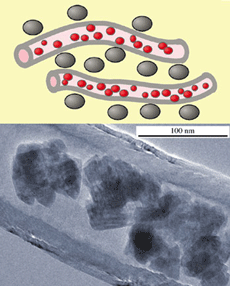Researchers have used carbon nanofibres to separate components of a highly sensitive explosive system to make it much safer to use
Researchers have used carbon nanofibres to separate components of a highly sensitive explosive system to make it much safer to use.
Nanothermites are versatile systems composed of a metal oxide and a reducing metal powder such as aluminium. The two components react in a very exothermic reaction, meaning the systems have potential applications as propulsion for rockets, explosives, or as pyrotechnic initiators. However, the mixtures are very sensitive so are difficult to handle in the lab, transport and integrate into systems that are going to be deployed elsewhere safely.

Now, Benny Siegert and colleagues at the National Centre for Scientific Research (CNRS) and the French-German Research Institute of Saint-Louis in north-east France have replaced the metal oxide nanoparticles that are usually used in nanothermite formulations with carbon nanofibres filled with manganese oxide (MnO2). ’There is no direct contact with the aluminium, and it makes ignition much more difficult and lowers the sensitivity, making it safer,’ says Siegert.
Siegert’s team used hollow carbon nanofibres with an internal surface chemistry that favours filling of the nanofibres rather than outside coating. They filled the nanofibres with molten manganese nitrate tetrahydrate (Mn(NO3)2.4H?2O), and then heated the system to very high temperatures to decompose the nitrate and produce the manganese oxide filled nanofibres.
To trigger the nanothermite system the team use a CO2 laser to break the nanofibres and ignite the reaction. But Siegert explains you could also use exploding wires - thin platinum wires with a capacitor inside. ’A small battery could make an impulse to explode the wires, making it very portable so that it could be easily integrated into device,’ he adds.
’This work establishes nanothermite as an accepted and completely regular origin of explosive and pyrotechnic material,’ says Niels Harrit at the University of Copenhagen in Denmark, who has experience working with nanothermites. ’It brings nanothermite into the mainstream of science,’ he adds.
Siegert believes that the success of this system to reduce the sensitivity of the nanothermite, could lead to civilian applications such as airbags in vehicles. ’When triggered the nanothermite could be combined with a gas generating compound to inflate the airbag,’ he says.
Mike Brown
References
et alJ. Phys. Chem. C, 2010, DOI: 10.1021/jp1014737






No comments yet